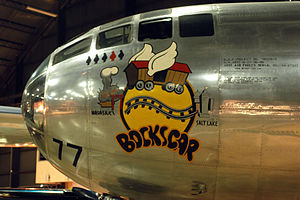Bockscar
| Bockscar | |
|---|---|
 |
|
| Bockscar nose art: the Fat Man silhouettes represent four pumpkin bomb missions (black) and the atomic bomb drop on Nagasaki (a red symbol, fourth in the line of five symbols) | |
| Type | B-29-36-MO Superfortress |
| Manufacturer | Glenn L. Martin Company, Omaha, Nebraska |
| Serial | 44-27297 |
| In service | April 1945 to September 1946 |
| Preserved at | The National Museum of the United States Air Force, Dayton, Ohio |
Bockscar, sometimes called Bock's Car, is the name of the United States Army Air Forces B-29 bomber that dropped a Fat Man nuclear weapon over the Japanese city of Nagasaki during World War II in the second – and last – nuclear attack in history. One of 15 Silverplate B-29s used by the 509th, Bockscar was built at the Glenn L. Martin Aircraft Plant at Bellevue, Nebraska, at what is now Offutt Air Force Base, and delivered to the United States Army Air Forces on 19 March 1945. It was assigned to the 393d Bombardment Squadron, 509th Composite Group to Wendover Army Air Field, Utah in April.
Bockscar was used in 13 training and practice missions from Tinian, and three combat missions in which it dropped pumpkin bombs on industrial targets in Japan. On 9 August 1945, Bockscar, piloted by the 393d Bombardment Squadron's commander, Major Charles W. Sweeney, dropped a Fat Man nuclear bomb with a blast yield equivalent to 21 kilotons of TNT over the city of Nagasaki. About 44% of the city was destroyed; 35,000 people were killed and 60,000 injured.
After the war, Bockscar returned to the United States in November 1945. In September 1946 it was given to the National Museum of the United States Air Force at Wright-Patterson Air Force Base, Ohio. The aircraft was flown to the Museum on 26 September 1961, and its original markings were restored. Bockscar is now on permanent display at the National Museum of the United States Air Force, Dayton, Ohio, next to a replica of a Fat Man.
...
Wikipedia
